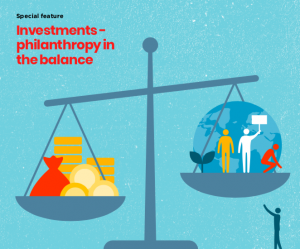It would sound odd to say that a majority of a foundation’s activities are not in pursuit of mission. However focusing staff and trustees’ time on grant-making can lead foundations to overlook the impact of their investment portfolio – which will be several multiples larger in monetary value. Investments and grant-making are often segregated, with grants closely probed and reported on, whilst investments can be dealt with via a cursory quarterly update.
This is changing. The urgency of the climate crisis and creating a sustainable economy which works for people and the planet, means that foundations which do not consider their investments within the wider societal and environmental context risk being on the wrong side of history. In addition, public scrutiny on who holds wealth in our society has intensified, most recently in the wake of events that have highlighted the disproportionate disadvantage facing Black and minority ethnic (BAME) groups. As holders of significant wealth (assets of £67 billion at last count of the top 300 foundations), it is paramount that foundations examine how they use the power this gives them.
Many foundations have long used investments to pursue mission and there are notable examples of foundations using their power as investors as a tool to achieve impact.
In its year-long inquiry, part of the Association of Charitable Foundation’s Stronger Foundations initiative to identify excellent practice, our member working group looked at the variety of practice when it comes to linking investments with mission, both from within the UK and international foundation sectors and without, including universities. It debated the knotty issues of impact, ethics, boards, and diversity, and how they relate to the practicalities of strategy, portfolio creation and working with investment managers.
These rich discussions informed the report we published earlier this month on how foundations can more closely integrate their investments with their mission, and consider the wider context within which their foundation operates. Investment: The Pillars of Stronger Foundation Practice identifies seven characteristics of excellent practice, including holding investment managers to account and seeking to influence the investment behaviour of others.
The first pillar – that each and every trustee has responsibility for the foundation’s investments – underpins everything that follows. While this might seem like the basics of regulatory compliance, in practice investment decisions are often delegated to a small subset of trustees, likely those with experience in the world of finance. This expertise is certainly valuable, but it is not the only relevant expertise. All trustees are experts on the foundation, its mission and its aims, and this is just as applicable when it comes to investment as it is to any other area of the foundation’s work.
So how do we bring start to see more of this in practice?
First, by empowering all trustees to participate in big picture discussions on investments and how the foundation’s investments relate to its wider goals. This could include basic training on investment practice and ensuring investment discussions are jargon free. Foundations will achieve progress thorough examination of the foundation’s mission and stance with regard to the wider societal and environmental context, so that investments can align, or at a minimum not conflict with the foundation’s wider goals. We need to ensure board cultures enable open, honest, and at times challenging discussion. A culture of learning can help create the conditions where all trustees feel empowered to ask questions and share views on the foundation’s investment approach, including in its interactions with investment managers.
Second, we need to address the lack of diversity on boards. Throughout the Stronger Foundations initiative we have clearly seen the value in perspectives from different sectors, backgrounds and approaches bring to foundation decision-making, and investment decisions are no exception. Exploring new approaches to responsible, sustainable and impact-driven investing, and hearing the voices of those who challenge established practice can enhance a foundation’s ability to pursue mission effectively.
Finally, we need to work towards greater transparency in the sector. As we explored in Transparency and Engagement: The Pillars of Stronger Foundation Practice, not only does greater openness foster public trust and confidence, but it allows foundations to learn from one another and raise the bar when it comes to collective practice. With better understanding of what our peers are doing and how, boards can feel more comfortable engaging with investment practice.
With more empowerment, more diversity and more transparency, we can work towards ending the segregation between grants and investment and maximise foundations’ potential impact. A well-managed investment portfolio is the engine that powers a foundation’s activity; to work towards a more ambitious and effective sector, foundations must examine how that engine operates.
Gail Cunningham is the Head of the Investment Learning Programme at ACF.
 Pre-order our upcoming issue: Investments – philanthropy in the balance.
Pre-order our upcoming issue: Investments – philanthropy in the balance.
The philanthropic world is facing mounting challenges from the impacts of climate change to inequality, global pandemics and authoritarian populism increase. At the heart of sector debates is the question of how foundations use their resources: not just the small amount for grantmaking and other charitable spending but the totality – most of which is invested in global capital markets in sectors such as aviation and pharma, through vehicles such as hedge funds and private equity and managed by discrete investment houses, many of whom are unknown to philanthropy practitioners let alone the wider public.





Comments (0)